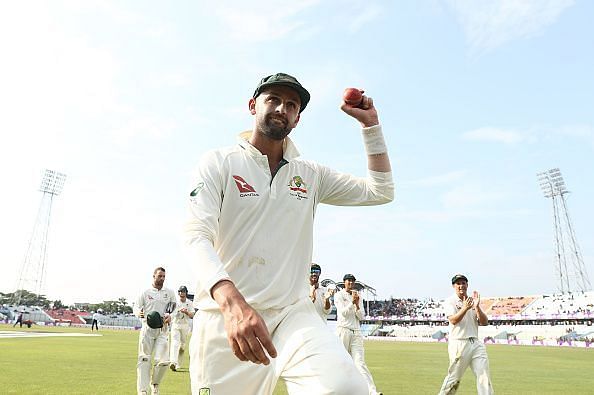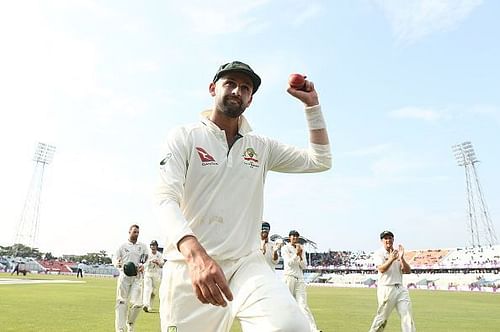
Is Nathan Lyon better than Ravichandran Ashwin?

On the face of it, this seems a ridiculous proposition. Nathan Lyon has 290 wickets in 74 Tests while Ravi Ashwin has amassed 311 in just 57. The Australian has collected 12 5-wicket hauls while the Indian offie has more than double this number – 26.
So how in the world can anyone make a case for Lyon being at par with Ashwin, leave alone being better than him?
In cricket, we know that stats are enlightening but there needs to be a deeper analysis than mere numbers to judge the quality of a player. Lyon indeed lags behind Ashwin on some parameters but when we look at the context within which they have been playing, the two appear much closer than a casual observer may imagine.
Being an Indian bowler, the Chennaiite has a major advantage over Lyon, he plays most of his cricket on spin-friendly Indian wickets. What has helped him even more is the fact that he started his career in that era of Mahendra Singh Dhoni’s captaincy when the team’s overseas performance had tanked and he had decided to revert to 90's method of winning Test matches at home – prepare spin-friendly wickets, rely on your batsmen to score heavy amount of runs and unleash the best spinners you have on the visiting batsmen.
It worked for Azharuddin in the 90s and Dhoni expected it work under him so that he can offset the disappointment of losses abroad by victories at home. Except for the England series in 2012, the strategy proved very successful for MSD and was carried forward by his successor Virat Kohli. Ashwin, first with Pragyan Ojha and then with Ravindra Jadeja regularly bundled out the opposition cheaply to spin India to victories.
Lyon, on the other hand, plays in the worst country for an off-spinner – Australia. This is due to the type of wickets Australia naturally produces – rock hard and not much prone to deterioration. It means there is hardly any rough to work with for the finger-spinners and there is consistent bounce which the batsmen can trust.
The pitches at Adelaide and Sydney sometimes allowed roughs to be created in the last couple of days of Tests but not nearly to the extent they do in most other countries.
How tough it is to be an off-spinner – in fact, a finger spinner – can be gauged by the history of Australian spinners and the records of visiting off spinners over the decades.
The pantheon of great Australian spinners is almost entirely made up of leg-spinners, who, due to generating more revolutions on the ball (a natural consequence of using wrist to spin the ball instead of fingers) benefit by the bounce in the wickets (because the over-spin on leg breaks produces extra bounce itself which along with what the pitch has to offer could create problems for the batsmen).
Bill O'Reilly, Clarrie Grimmett, Richie Benaud, Shane Warne and even Stuart MacGill are the biggest names in Australia’s spin bowling history. When it comes to off-spinners, there are merely three names - Ashley Mallet (132 wickets in 38 Tests), Bruce Yardley (126 wickets in 33 Tests) and Tim May (75 wickets in 24 games) - who managed modestly good records before Lyon in the post-World War 2 era.

Also, if we look at the records of the visiting off-spinners in Australia, it’s noticeable that only the finest in the history of the game have achieved success down under, the likes of Erapalli Prasanna, Lance Gibbs and Hugh Tayfield. Indeed, it could be said that bowling in Australia is the litmus test for off-spinners to see whether they belong to the great or just the good category.
Even off-spinners of the quality of Harbhajan Singh and Muttiah Muralitharan never had a great time in that country. Saqlain Mushtaq managed only one five-for in Australia and apart from picking up five wickets in the last innings of the Adelaide Test of 2010 and bowling his side to victory, Graeme Swann also didn’t have great stats over there.
The only finger spinner to make an impact in Australia in recent years was Rangana Herath in Sri Lanka’s 2012-13 tour.
Looking at things in this context, it is impossible to not admire what Lyon has achieved. And that’s not all. Apart from the lack of help available to him, it also needs to be remembered that he has to usually play the role of a supporting bowler and see most of the wickets being mopped up by pacers whereas Ashwin usually has the stage set for him on dry wickets to harvest a rich haul of scalps.
It will be very interesting to compare the records of the players in the two countries to which they belong. Lyon has an average of 33.74 and a strike rate of 66.5 at home while Ashwin averages 54.71 in the same country and gets a wicket every 97 balls.
In India on the other hand, Lyon’s average and strike rate are 30.58 and 51.7 respectively compared to Ashwin’s 23.04 and 50.
So in the most challenging conditions for offies, Lyon comes out as the better bowler and in helpful conditions, Ashwin’s numerical superiority isn’t as glaring.
On top of that, it has to be remembered that when Ashwin bowls in India, he is usually up against batting line-ups who are highly vulnerable to spin (for instance Australia in 2013) and their technical deficiencies become more pronounced on dry wickets. Compared to that, Lyon, playing in India, had to bowl to native batsmen who are more efficient, comparably, against the turning ball.
Ashwin’s fans might retort by saying that Lyon has one big advantage over his Indian counterpart. He often has great support from the seamers who are the lead strike bowlers of his team whereas Ashwin has to lead the charge himself on most occasions for India.
This argument is valid but can be turned around in Lyon’s favour by observing that because Australian seamers are much more potent in Australia than Indian pacers on their home soil, they tend to take majority of the wickets leaving only a few wickets for Lyon to pick whereas Ashwin has most scalps waiting to be grabbed and only Jadeja to share them with.
All in all, Ashwin, with highly favourable conditions is at a huge advantage compared to Lyon. Other factors stated above make the Australian’s handicap against his Indian rival even more pronounced. In view of these facts, it is highly justified that Lyon can at least be considered at par with Ashwin in terms of quality, even if considering him better is too radical a thought for many.